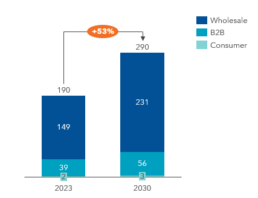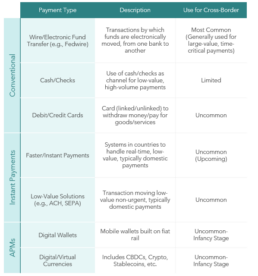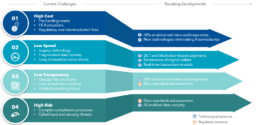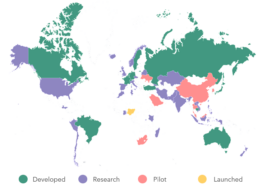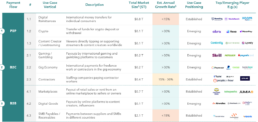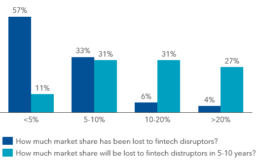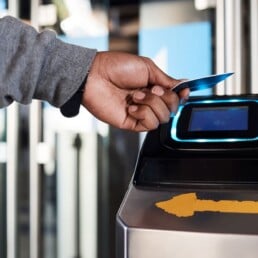Cross Border Payments: The Big Picture
While the world may be witnessing a shift towards de-globalization, cross-border payments are experiencing a surge. This is driven by several trends picking up pace over recent years, including: (1) expansion and fragmentation of supply chains into new countries, (2) growing cross-border asset management and investment flows, and (3) previously underbanked populations getting access to modern financial tools.
Cross-border payments are estimated to grow to ~$290 trillion by 2030 — an increase of $100 Trillion in less than a decade (Exhibit 1). The global cross-border payments industry generated a revenue of $181.9 billion in 2022 and is expected to reach $356.5 billion by 2032.(1)
While instant payments have become ubiquitous domestically, the cross-border payments landscape, with 195 countries each possessing distinct payment systems, regulations, and technological maturity levels, presents a unique challenge.
This complexity is also an opportunity for those prepared to leverage the emerging wave of disruption to reduce friction in international payments. Newer technologies are expected to play a crucial role
— ranging from the latest generation of real-time payment rails to emerging blockchain networks.
As the cross-border money movement ecosystem is shaken up by emerging competition and technologies, there will inevitably be new winners and losers.
This paper examines the emerging trends in this market and the opportunities available to market participants at this pivotal time.
Exhibit 1. Cross-Border Payments, 2023-30
(in US$ Trillions)(2)
The Current Complexity:
Today, in a cross-border transaction, the sender selects a front-end provider (bank or money transfer operator) to initiate payment. The receiver gets the payment through the chosen medium. Although traditionally via the Correspondent Banking Network (CBN), now new back-end networks have emerged to optimize payments, enhance interoperability, and expand sender-receiver possibilities.
Exhibit 2.Cross Border Market Participants(3)
Ways to make a cross border payment (4)
Industry Evolution
The industry has long grappled with a myriad of challenges, ranging from the intricacies of diverse regulatory frameworks to the complexities introduced by numerous intermediaries. Historically, cross-border payments have been known to be slow, expensive, risky, and non-transparent. However, these hurdles have spurred a wave of innovation and transformation, necessitating regulatory advancements.
Exhibit 3. Emerging Trends
The Changing Dynamics
Today, the global cross-border payment landscape is at the center of several trends that could fundamentally change the competitive dynamics.
TECHNOLOGICAL ADVANCE
A. API-enabled real-time exchange rates
API frameworks revolutionize banking, offering real-time FX rates, faster reconciliation, and rate-lock flexibility. Remitly and TransferWise leverage this for scalable, innovative cross-border payment solutions, enhancing customer transparency and inclusivity.
B. Multi-currency digital wallets
Digital Wallets are gaining popularity, especially among underbanked customers. Several multi-currency wallets now offer cross-border payment capabilities without creating local accounts. Such payments are not only faster, but also cheaper, more accessible, and offer a better experience. Examples for businesses and consumers include Airwallex, PayPal, Alipay, WorldRemit, and Skrill. Additionally, fintechs like Revolut and Wise are challenging traditional remitters like Western Union (WU) and MoneyGram who have always faced the last mile problem.
C. Potential disruption by CBDCs
Today, most Centrally-Backed Digital Currencies (CBDC) serve as legal tender and come in two forms: account-based (linked to a bank account) and token-based (stored in a digital wallet). They aim to revolutionize payments by offering a more secure, efficient, and cost-effective payment method. While they facilitate payment settlements and foreign exchange, they haven’t become a mainstream money transfer method yet. If they gain global popularity, CBDCs could significantly disrupt the banking sector.
Exhibit 4. CBDC Development Status, 2023
D. Real-time transaction models
While government-sponsored RTP networks offer cost-efficient real-time transfers, interoperability has been a challenge. The governments of a few countries have started building tech stacks, integrating other technologies, and driving the strategy globally. For example, India (through UPI stack) and Singapore (PayNow) entered one such cross-border partnership which is fully cloud-based. P27 in the Nordics provides instant cross-border payments between Denmark, Finland, and Sweden. Thailand and Singapore linked their real-time payment systems in April 2021, creating the first instant cross-border payment infrastructure
E. AI-enabled data security
Apart from the long-known applications such as KYC and targeted sales, RegTech and AI are widespread in fraud detection, watchlist screening, optimizing payment routing, etc. Modern fraud tactics are complex, and traditional fraud detection methods are unable to keep up with the evolving landscape. AI/ML is uniquely placed to identify fraudulent events across vast volumes of cross-border transactions. AI-enabled transaction and relationship analytics identifies anomalous behavior and provides deep and accurate insights into risk. Unsupervised AI models can optimize and calibrate alerts to reduce false positives.
F. DLT and Blockchain-based payments
Stablecoins (e.g., USDC, USDT, Digital Pound) drive real-time payments, sidestepping SWIFT’s delays. Alternative blockchain payments (e.g., Red Date Technologies) are aiming to break its monopoly. Fintechs and incumbents, including RippleNet (a network of banks and payment providers that moves funds worldwide with minimal fees), J.P. Morgan’s Liink, and Visa B2B Connect, are increasingly innovating with blockchain payments.
Exhibit 5. Real-time Payment Systems, 2024
REGULATORY ADVANCES
Data Standards
A. Swift Global Payment Innovation (GPI)
Swift GPI (2016) was launched to improve the speed, traceability, transparency, and security of x-border payments. Since then, more than $300 billion has been traded daily via GPI in 150 different currencies and between more than 4,000 financial institutions.
In addition, Swift has launched an initiative, Swift Go, to improve the processing of low-value cross-border payments. This solution is closely linked to Swift GPI and ensures a transparent client experience through predictable processing fees and transparent end-to-end FX transactions.
B. Immediate Cross-Border Payments (IXB)
The IXB initiative aims to connect two instant payment systems, RTP in USD and RT1 in EUR, across the Atlantic, to facilitate and support payments in one of the world’s largest financial corridors.
C. ISO 20022: Consistent Data to Improve Transactions
With the complete shift to ISO 20022 (a standard for exchanging electronic messages that use XML syntax) in 2023, FIs will have access to consistent and structured data – including communication of cross-border payments – that can be used in several transactions.
Where does the opportunity lie?
Cross-border payments are brimming with opportunities for disruption. Traditional methods are often slow, expensive, and lack transparency. This has created a fertile ground for innovative solutions involving:
- Emerging Use Cases: Newer payment use cases are constantly emerging, driven by the rise of the gig economy, e-commerce platforms, and a more globally connected world. These new use cases demand faster, cheaper, and more user-friendly ways to send and receive money across borders.
- New Business Models: FinTechs and innovative startups are reimagining the cross-border payments landscape by leveraging technologies to create more efficient and cost-effective solutions, unbundling traditional banking services, and offering specialized and tailored solutions to meet rising customer demands.
- New Segments and Corridors: As the global economy continues to integrate, previously underserved segments and corridors provide growth opportunities. This includes reaching unbanked populations, facilitating micropayments, and enabling seamless cross-border transactions between emerging markets.
1. Emerging Use Cases
2. New Business Models
Fintechs are targeting banks’ share in cross-border payments, easing pain points caused by outdated systems and regulations. The focus is on low-value transactions, often overlooked by traditional providers. Firms such as Wise, Ripple, and Revolut are disrupting the space with multi-currency apps, making cross-border payments faster and cheaper. Banks have been slow to respond. As a result, 40% of the banks are already experiencing a ~5% decline, and 89% are anticipating further loss over the next 5-10 years.
A. Unbundled Banking Services
- Multi-currency payment apps and wallets. Fintechs introduce user-friendly digital wallets that support multiple currencies, providing users with the flexibility to transact seamlessly across borders.
For Businesses: Veem, Airwallex, Flywire
For Individuals: TransferCo, MangoPay, Transfer Galaxy - Fintech-as-a-Service. Offering modular financial services that can be integrated into other businesses’ platforms. E.g., Rapyd is a FaaS platform that allows businesses to embed fintech services, including cross-border payments, into their applications.
- Regulatory Technology (RegTech): Focusing on regulatory compliance and navigating the complex landscape of cross-border regulations. E.g., ComplyAdvantage specializes in anti-money laundering (AML) and know-your-customer (KYC) solutions.
B. Emerging Use-Case-Based Solutions
- Digital Currency Exchange and Forex Services: Specializing in providing foreign exchange services to businesses and individuals with enhanced convenience such as doorstep delivery, real-time FX rates, etc. E.g., OFX (formerly OzForex) focuses on international money transfers and currency exchange for businesses and individuals. It offers competitive rates and tools for managing forex exposure.
- International Trade Facilitation: These streamline processes, reduce costs, and enhance visibility for businesses involved in international trade. E.g., Zepz specializes in simplifying and optimizing global supply chain management by streamlining processes, reducing costs, and enhancing visibility for businesses involved in international trade.
- Cross-Border Investment Platforms: Concentrating on facilitating cross-border investments and wealth management.
E.g., Interactive Brokers provides a platform for global trading and investment, allowing users to invest in a wide range of assets across different markets.
C. Collaboration Powerhouse
- Leveraging Fintech’s Agility and Technology: Established banks are integrating Fintech’s open APIs to offer their customers access to innovative payment functionalities like real-time currency conversion and multi-currency wallets directly within their existing banking platforms. E.g., US-based SouthState Bank is working with cloud payments provider Volante Technologies to deliver “faster and more flexible payment options” to its customers.
- Expanding Reach and Market Access: Established institutions with a global footprint are partnering with regional or niche Fintechs to expand their reach into new markets. E.g., TransferMate and Barclays have announced a new collaboration to bring an international receivables solution to the market, to help UK firms reduce costs.
- Co-creation of New Solutions: Established players and Fintechs are co-creating entirely new solutions by combining their resources and expertise. This involves developing innovative payment products or platforms specifically tailored to address the challenges of cross-border transactions. E.g., Santander ’s collaboration with Ripple, an early mover, leveraged the startup’s blockchain technology to launch One Pay FX—an international money transfer service offering rapid, transparent, and cost-effective cross-border payments.
Exhibit 6. Loss to FinTechs/Disruptors(6)
NEW SEGMENTS AND CORRIDORS
A. SMEs in International Business: One of the biggest growth opportunities as the SME segment has typically been underserved in the market, with banking products often skewing towards consumer banking or large corporations. E.g., Doku: An Indonesian fintech company facilitates domestic and international payments with a focus on SMEs.
B. Rising Global E-commerce: ~15-20% of e-commerce transactions are international, growing steadily in B2B and C2B (see Exhibit 6) due to low-cost transport, small-item purchases, improved transaction security, and reduced red tape. E.g., Checkout.com: A Dubai-based payment gateway catering to e-commerce businesses globally, with features facilitating payouts to sellers across borders.
C. Continued Focus on B2B: The ongoing mix shifts in underlying macro and sector trends play to the strength of new entrants and challenge incumbents. However, the biggest cross-border payment segment is business-to-business (B2B), generating revenues at least three times those of consumer-facing activities. E.g., Marco Polo: A trade finance network powered by blockchain technology, facilitating secure and efficient B2B payments with reduced processing times.
D. Emerging Markets: Surging demand for cross-border payments in growing consumer markets like the Middle East, Southeast and South Asia, and Latin America opens significant opportunities. These regions, marked by rising consumer classes and urbanization, seek innovative banking services, creating a fertile ground for tech-driven solutions. E.g., Flutterwave (Africa): A leading African fintech company offering mobile and online payment solutions for businesses and individuals. They facilitate cross-border transactions within Africa and beyond.
In Closing...
Significant shifts are underway in the cross-border payments sector, across the demand-side and supply-side. Consumer expectations from domestic payments (instant, fully traceable, risk-free, etc.) are being applied to the more complex cross-border space. Businesses that capitalize on these shifts stand to shape the future of the industry. The roadmap to success requires investing in new capabilities, leveraging partnerships, and redesigning user experience focusing on three core principles :
- End-to-end Transparency: Establish greater control over payment routing and a truly customer-centric mindset to deliver up-front visibility into status and costs at every stage from sender to receiver
- Speed: Maximize 24/7 availability of systems and near real-time delivery of payments to gain a significant competitive edge and grow market share
- Cost-effectiveness: Leverage investments or partnerships to tap into the most cost-effective channels for cross-border money movement, while using technology to manage FX risks
__________________________________________________________________________________________________________
- McKinsey Global Payments Report, 2023
- Statista, 2022
- Softjourn
- Citi GPS
- Market Size estimated for small ticket transactions (>$50k) considering scope for disruption;
Source: UNCTAD World Investment Report 2023; Kepler Cannon Analysis - Citi Treasury and Trade Solutions – Future of Payments Survey, May 2023
- FXC Intelligence Market Sizing, 2023
